Thessaloniki, Thessaloniki, Central Macedonia 作者: 来源: 发布时间:2021-03-30
I. Population, Area
Total Area: 19.307 km2 (7.454 sq mi)
Elevation: Highest elevation 250 m (820 ft) Lowest elevation 0 m (0 ft)
Population: 315,196 (2011)
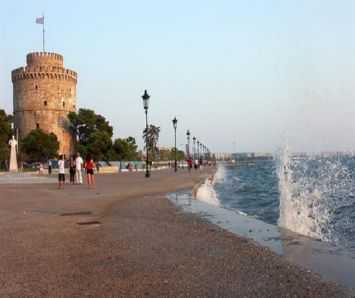
II.Natural Geography
Thessaloniki lies on the northern fringe of the Thermaic Gulf on its eastern coast and is bound by Mount Chortiatis on its southeast. Its proximity to imposing mountain ranges, hills and fault lines, especially towards its southeast have historically made the city prone to geological changes.
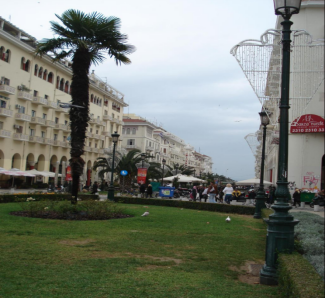
Since medieval times, Thessaloniki was hit by strong earthquakes, notably in 1759, 1902, 1978 and 1995. On 19–20 June 1978, the city suffered a series of powerful earthquakes, registering 5.5 and 6.5 on the Richter scale.The tremors caused considerable damage to a number of buildings and ancient monuments, but the city withstood the catastrophe without any major problems.One apartment building in central Thessaloniki collapsed during the second earthquake, killing many, raising the final death toll to 51.
Climate
Thessaloniki's climate is directly affected by the sea it is situated on. The city lies in a transitional climatic zone, so its climate displays characteristics of several climates. According to the Köppen climate classification, city has a Mediterranean climate (Csa), bordering on a semi-arid climate (BSk), observed on the periphery of the region. Its average annual precipitation of 450 mm (17.7 inches) is due to the Pindus rain shadow drying the westerly winds. However, the city has a summer precipitation between 20 to 30 mm (0.79 to 1.18 inches), which prevents it from qualifying as a Mediterranean climate (Csa), and increases gradually towards the north and west, turning humid subtropical.
III. ECONOMY
Thessaloniki rose to economic prominence as a major economic hub in the Balkans during the years of the Roman Empire. The Pax Romana and the city's strategic position allowed for the facilitation of trade between Rome and Byzantium (later Constantinople and now Istanbul) through Thessaloniki by means of the Via Egnatia. The Via Egnatia also functioned as an important line of communication between the Roman Empire and the nations of Asia, particularly in relation to the Silk Road. With the partition of the Roman Emp. into East (Byzantine) and West, Thessaloniki became the second-largest city of the Eastern Roman Empire after New Rome (Constantinople) in terms of economic might. Under the Empire, Thessaloniki was the largest port in the Balkans. As the city passed from Byzantium to the Republic of Venice in 1423, it was subsequently conquered by the Ottoman Empire. Under Ottoman rule the city retained its position as the most important trading hub in the Balkans. Manufacturing, shipping and trade were the most important components of the city's economy during the Ottoman period,and the majority of the city's trade at the time was controlled by ethnic Greeks. Plus, the Jewish community was also an important factor in the trade sector.
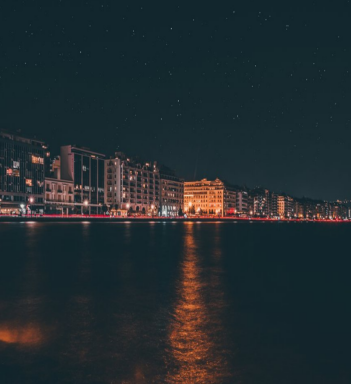
Historically important industries for the economy of Thessaloniki included tobacco (in 1946 35% of all tobacco companies in Greece were headquartered in the city, and 44% in 1979) and banking (in Ottoman years Thessaloniki was a major center for investment from western Europe, with the Bank of Thessaloniki having a capital of 20 million French francs in 1909).
IV. Attractions
1.Roman Rotunda (Saint George's Church)
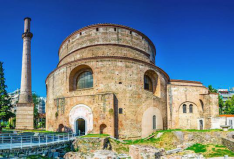
The Roman Rotunda is Thessaloniki's most magnificent ancient monument. Built in the early fourth century, it was most likely intended to be Emperor Galerius' mausoleum (although he was not buried here) and was part of the complex that included the Galerius Palace and the Arch of Galerius.
Emperor Theodosius the Great, who was baptized as a Christian in Thessaloniki, converted the mausoleum into a Christian church in the late fourth century. During the 10th to 12th centuries, the Rotunda was used as the Cathedral of Thessaloniki. Under Ottoman rule, the building was converted to a mosque; the minaret is a relic of the Islamic era. After the liberation from the Turks in 1912, the Rotunda was transformed into the Church of Saint George (Áyios Yeóryios).
This grandiose sanctuary makes a breathtaking impression. More than 24 meters in diameter and 30 meters in height, the Rotunda features cylindrical domed architecture similar to the Pantheon in Rome. Inside, gorgeous mosaics decorate the dome and the vaulted recesses. The mosaic in the center of the dome is missing, but below it are charming figures of angels and architectural facades on a gold background. The Rotunda houses a Sculpture Museum and is open to the public daily for visits.
2.The White Tower: Relic of the Byzantine-Era Ramparts
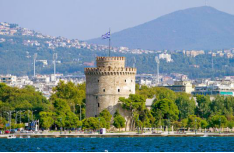
The most recognizable landmark of Thessaloniki, the White Tower can be reached by taking a scenic walk along the Seafront Promenade. In a small public garden at the southern end of the promenade, the White Tower (Lefkós Pyrgos) was once part of the town's ancient ramparts. The circuit of fortification walls no longer remains completely intact; the White Tower is the only relic of the seaward defenses. Built by the Ottoman Turks around 1530, this imposing tower was used mainly as a prison.
Today, tourists can visit the tower and ascend to the viewing platform on the top, which offers sensational views of the city and harbor. The White Tower also houses the permanent collection of the Museum of Byzantine Culture. The museum's exhibits educate visitors about Byzantine history and art in Thessaloniki from around AD 300 until its capture by the Turks in 1430. The collection includes a wide range of artifacts such as early Christian coins, vases, mosaics, wall paintings, and liturgical objects.
The White Tower also hosts temporary exhibitions such as presentations of Byzantine religious paintings.
V. History
Thessaloniki was founded in 315 BC by King Cassander of Macedonia. It rapidly became a very important center and one of the major cities of the kingdom during the Hellenistic Era with limited political autonomy.
After the fall of the Kingdom of Macedon in 168 BC it became part of the Roman republic and was further developed into an important trade center actually connecting Europe with Asia through the Roman Via Egnatia.
Many of the most imposing and well decorated structures were built during the Roman Era of its history as Thessaloniki was one of the capitals during the Tetrarchy period, while it also served as capital of all the Greek provinces for a period of time.
During the first century AD and afterwards, the city became one of the first early Christian centers after Paul the Apostle preached here and laid the foundations for a new religion.
During the Byzantine era the city was further developed and became even bigger, being the second most important city of the empire after Constantinople itself. Wonderful churches and other buildings were built in several areas while extended defensive constructions took place.
In 1204 AD during the fourth crusade the city fell into the hands of the Crusaders and thus the “Kingdom Of Thessalonica” was created. In 1246 though, the Byzantines managed to recover the entire area.
In October 27, 1912 during the first Balkan War the Greek army liberated the city, while in 1917 the city faced what was perhaps its greatest disaster ever, as a huge fire destroyed almost three quarters of the center something that had various side effects in the following years. Serious efforts and proposals were made by famous architects like Ernest Hebrard in order for the city center to be rebuilt like a modern European capital.
During the 50’s and the 60’s the city experienced an unprecedented construction growth that transformed the city center to its present form. (Click here to view some rare photos dated back to these decades.)
Today Thessaloniki is a modern European city, as always an important trade and transportation center connected to all the Balkan Countries, while it was nominated as the Cultural Capital of Europe in 1997.
VI. Other Information
It is one of the largest student centers in South-Eastern Europe while many of its monuments are included on the UNESCO World Heritage List.
In 2004 during the Athens Olympics, the city hosted a number of athletic events while being one of the Greek Olympic Cities. Finally the city was selected in 2011 as the European Youth Capital of 2014.
